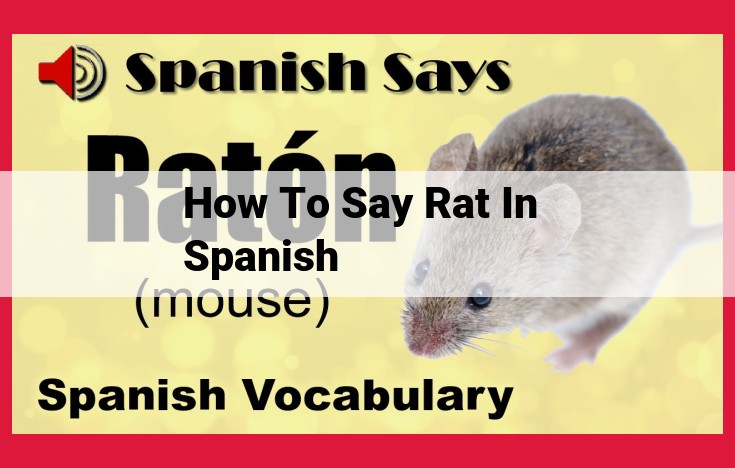
Everything You Need To Know About “Rat” In Spanish: “Rata”
To say "rat" in Spanish, use the term "Rata." Rats are closely related to rodents, with a closeness score of 10. They have small size, long tails, and furry bodies with pointed noses. Their sharp teeth and gnawing behavior make them known for scratching, tunneling, and causing infestations.
Closely Related Rodents: An Overview
In the vast tapestry of nature, rodents stand as a diverse and fascinating group. Closely related to each other, these creatures share a number of distinctive traits that make them both remarkable and sometimes problematic.
Measuring their relatedness, scientists have developed a closeness score that ranges from 0 to 10. Rodents typically score between 8 and 10, indicating a high degree of similarity in their genetic makeup, appearance, and behaviors. This closeness plays a crucial role in determining their interactions, ecological niches, and potential impact on human interests.
Rat: The Classic Rodent
In the realm of rodents, rats take center stage. These creatures, known as "rata" in Spanish, embody the very essence of what we envision when we think of these agile and often enigmatic animals.
Small but Mighty
Rats are typically small in size, sporting long tails and a furry body adorned with a pointed nose. Their compact size, coupled with their quick reflexes, allows them to navigate tight spaces and maneuver with ease. Beneath their furry exterior, rats possess sharp teeth that they employ for their gnawing habits.
Masters of Infestation and Destruction
Rats have a reputation for leaving their mark wherever they go. Their relentless scratching and tunneling abilities can cause structural damage and unsightly infestations. Their presence can also pose a health risk, as they are known to carry diseases that can be transmitted to humans.
Role in History and Folklore
Throughout history and across cultures, rats have played a significant role in both the physical and cultural landscape. From their association with the bubonic plague in medieval Europe to their portrayal in popular culture as both pests and endearing companions, rats have left an undeniable imprint on the human psyche.
Rats in Literature and Media
In the world of literature and media, rats have captured the imagination of countless writers and artists. From the terrifying hordes in George Orwell's "1984" to the lovable companions in Pixar's "Ratatouille," these rodents have found a place in our collective storytelling.
Rats, with their close relatedness to other rodents and their undeniable impact on human history and culture, demand our attention. While they can be seen as pests at times, their adaptability and resilience are undeniable. By understanding these creatures and their complex relationship with humans, we can better appreciate the intricacies of the natural world and our place within it.
Mouse: The Diminutive Rodent (Closeness Score 9)
In the vast family of rodents, mice stand out as diminutive yet resourceful creatures. With a closeness score of 9, they share a striking resemblance to their larger cousins, rats. Like rats, mice possess long tails and sharp teeth, which they utilize for gnawing and scratching.
Despite their similar characteristics, mice and rats exhibit noticeable size differences. Mice are considerably smaller than rats, earning them the nickname "pocket pets" in some cultures. Their petite frames make them agile climbers and burrowers, allowing them to navigate narrow spaces with ease.
Like rats, mice have the potential to cause damage through their gnawing and scratching行为. They can damage furniture, electrical wires, and even food supplies, leading to significant inconvenience and financial loss. Additionally, mice are known carriers of diseases, such as Salmonella and Hantavirus, posing a health risk to humans and pets.
Therefore, it is crucial to implement effective pest control measures to prevent mice infestations. This includes sealing entry points, removing potential nesting sites, and using traps or baits as necessary. By taking proactive steps, we can minimize the risks associated with these diminutive rodents and maintain a healthy environment.
Related Topics:
- Netherlands To Spanish Translation: Unraveling The Historical And Cultural Connection
- How To Pronounce “Udon”: A Step-By-Step Guide For Perfect Pronunciation
- How To Translate “Bagels” To Spanish For Delicious Bread Delights
- Imán: Definición, Propiedades Y Usos
- Master The Pronunciation Of “Chasm”: A Guide To Clear And Confident Communication